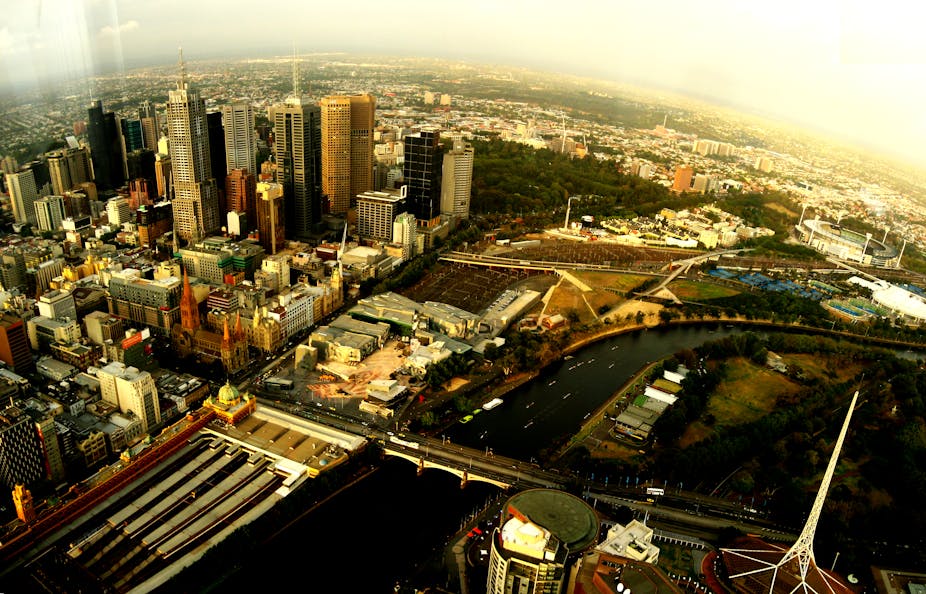It’s a debate that’s been raging for decades and dominates academic and popular urban planning discourse: urban sprawl versus urban densification. Is it better to increase density or to expand at the edges? Each camp has its fervent supporters and truckloads of data to back themselves.
The enduring nature of the debate suggests that we’ve reached a stalemate that is unlikely to be broken by proponents of either side simply shouting louder.
This is not a simple black and white argument, and there are often unacknowledged trade-offs that arise when one stance is pitched against the other.
Food production
Concern about the loss of traditional farmland for urban development has been growing in recent times in Australia. Media and academia alike have warned of a threat to food security as cities rely increasingly on mass-produced agricultural products from distant Australian and international producers. Concern over food miles has led many commentators to call for greater protection of peri-urban agricultural land.
Simultaneously there are calls for the growth of urban agriculture. Food produced within the urban matrix can occur in high density urban contexts, but it’s perhaps most effective in low-density suburban areas where backyards offer ample space. Designing cities to maximise urban agriculture may therefore have the perverse outcome of the expansion of city boundaries into traditional farmland.
Human health and well-being
The recent focus on neighbourhood design and its role in supporting health and well-being has also made its way into the debate about density. For example, low density arrangements usually provide better access to nature through the greater availability of (public and private) green space. Green space is important for exercise and social interaction, while contact with nature more broadly can improve mental well-being and provide psychological restoration.
However, due to their distance from the city centre, low density suburbs can be isolating. They often lack services and involve long commuting times; all of which have negative impacts on health (for example increasing sedentary behaviour). Although high density neighbourhoods can address many of these issues, they also have their own problems: noise and air pollution, traffic congestion, fear of crime and a deficit of green open space. In short, there is no right or wrong answer, since different aspects of health and well-being are accommodated more easily by high and low density urban arrangements.

Biodiversity conservation
As cities expand into the surrounding peri-urban landscape, swathes of native vegetation can been lost. Classic examples in Australia include Sydney’s Cumberland Plain Woodland (9% of the original extent remaining) and the Volcanic Plains Grasslands outside Melbourne (less than 1% remaining). Green open spaces such as parks, reserves, and riparian corridors and gardens are key to promoting biodiversity within cities. Promoting these spaces in urban planning may lead to a larger urban footprint and thus have both positive and negative impacts on biodiversity, depending on the spatial scale and conservation objectives concerned.
Energy efficiency
Cities with low density housing and high levels of car dependency are criticised for being energy intensive. Arguments are therefore often made for cities to be as compact as possible.
Maximising public transport connectivity and minimising commuting time are important. However, the energy consumed by a city is far more complex than whether it is characterised by high or low density urban form.
The design of suburbs, efficiency of building stocks, use of appliances and technologies, and how the daily lives of citizens are organised also play a significant role. Therefore, increasing density alone does not guarantee improved energy efficiency.
Moving on from the current debate
The dichotomy between urban sprawl and urban densification is false. More worryingly, it hinders our ability to make decisions for creating sustainable, healthy and equitable cities of the future.
Cities are highly complex and multifaceted socio-ecological systems, and an equally sophisticated decision-making framework is required to plan their future.
Ultimately, we need to move past the tired debate about one urban form versus another. A new discussion based on desired end states for urban sustainability must be started.
Rather than a one-size-fits all solution, special attention should be given to the spatial and unique requirements of the people, species, and ecosystems that comprise cities. With this starting point, we can transcend the current stalemate to ensure our cities are planned and designed to meet the sustainability challenges of the future.

